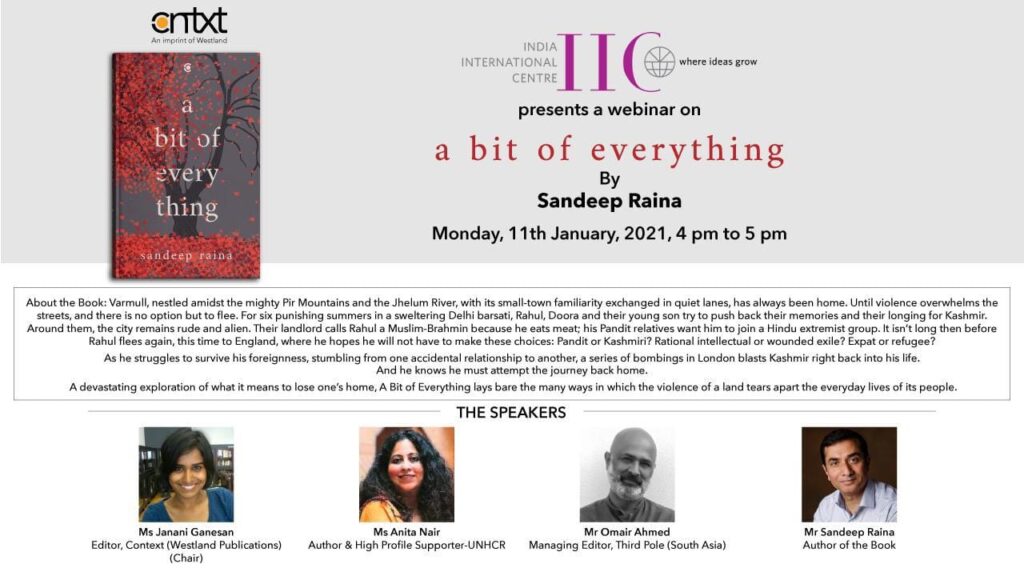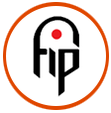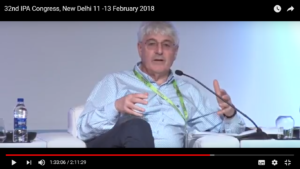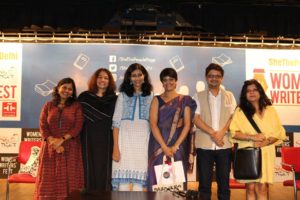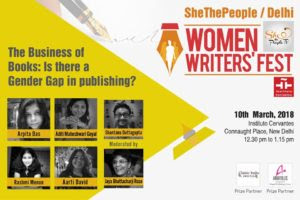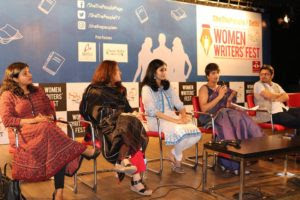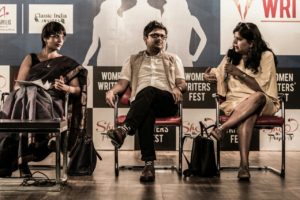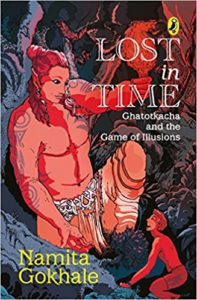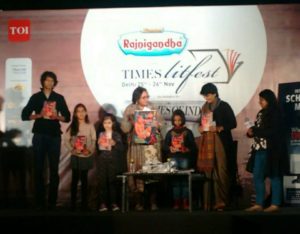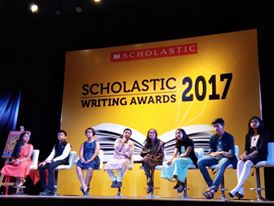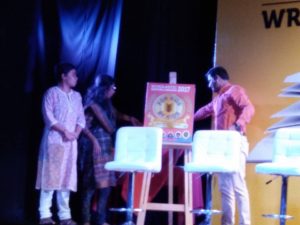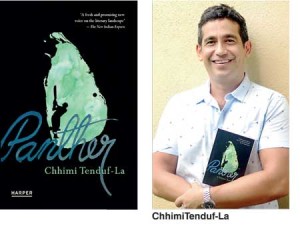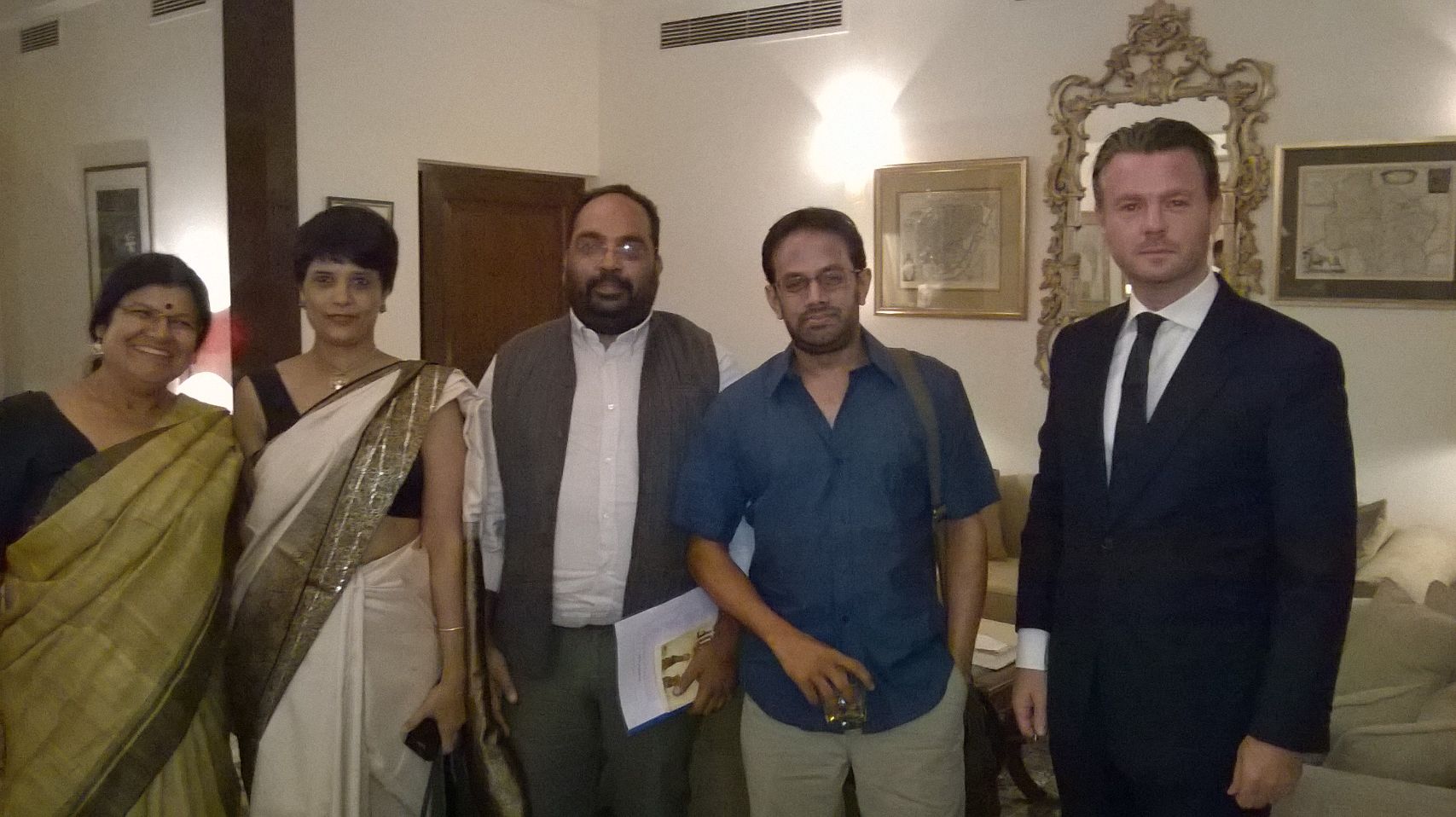Press Release

(L-R) Paro Anand, Jaya Bhattacharji Rose, Amandeep Sandhu, Samanth Subramanian and H.E. Ambassador Feilim McLaughlin
On Thursday, 16 Oct 2014, H.E. Ambassador Feilim McLaughlin of Ireland hosted a literary soiree at his residence. It was organized to commemorate the centenary of World War I. The event consisted of an exhibition on the Irish poet W.B. Yeats and a panel discussion on “Conflict and Literature”. The panelists were three Indian authors/journalists—Paro Anand, Samanth Subramanian and Amandeep Sandhu and the discussion was moderated by Ambassador McLaughlin. Ambassador of Ireland Feilim McLaughlin said the event was intended to explore the role of the writer in portraying or interpreting conflict, drawing parallels between the experience in Ireland and South Asia. The evening was curated by Jaya Bhattacharji Rose.

Panel discussion on “Conflict and Literature”, moderated by H.E. Ambassador Feilim McLaughlin
It was a one-of-a-kind evening with the lovely ambience and Irish music playing in the background. The three panelists were authors who had lived, worked with or interviewed persons in conflict zones in different parts of South Asia. Their personal stories and reading of relevant portions from their published works were straight from the heart. The invitees were handpicked. The three Indian authors who spoke were Paro Anand whose YA novel No Guns at My Son’s Funeral is being turned into a film; Amandeep Sandhu, author of the critically acclaimed testimonial fiction Roll of Honour and Samanth Subramanian who has recently published The Divided Island, reportage from Sri Lanka. The select audience were mesmerized silent by the readings and interaction of the authors. Several shed a tear or two. Most had a lump in their throat. The topics or narrated experiences hit a raw chord in many, especially those with a background or family from Partition, ’84 riots and communal conflicts. Author, Dr Kimberley Chawla says, “In this day and age, one tends to forget or ignore conflict past or present that may be occurring just a few hundred kilometres away, but it continues to be relevant. This literary event brought it right back home and reminded all present how lucky we were to have what we have and that we or our families managed to survive.” Many in the audience were seen congratulating the Irish embassy for pulling off such a topic which actually left the audience sentimental and empathic and there were no accusatory or aggressively political arguments or comparisons with other countries. Remarkably there was pin drop silence throughout the event.
the authors. Several shed a tear or two. Most had a lump in their throat. The topics or narrated experiences hit a raw chord in many, especially those with a background or family from Partition, ’84 riots and communal conflicts. Author, Dr Kimberley Chawla says, “In this day and age, one tends to forget or ignore conflict past or present that may be occurring just a few hundred kilometres away, but it continues to be relevant. This literary event brought it right back home and reminded all present how lucky we were to have what we have and that we or our families managed to survive.” Many in the audience were seen congratulating the Irish embassy for pulling off such a topic which actually left the audience sentimental and empathic and there were no accusatory or aggressively political arguments or comparisons with other countries. Remarkably there was pin drop silence throughout the event.
Keki Daruwalla, Novelist, Poet and Chairperson, DSC Literature Prize 2014: “I feel it was a very fine evening. The Ambassador Mr. Feilim McLaughlin had done his homework. (One normally doesn’t see Their Excellencies getting into the nitty-gritty of a cultural event). The mix was perfect with Paro Anand speaking of the handicapped children. It was very moving. Amandeep Sandhu spoke of 1984. Wish he had read more from his book.”
M. A. Sikandar, Director, NBT ( National Book Trust of India) “A wonderful evening with Authors who highlighted the flip side if real India. I amazed by the intense of reading by these authors who are from diverse background and culture. Credit goes to the Irish Ambassador and Jaya.”
Paro Anand : “Trying to make sense of a long ago war through today’s conflicts brought three writers together. IN the peace of Delhi’s Diplomatic Enclave, we wove words of wars and conflicts that do and don’t belong to us….each telling of our engagement with wars without as much as within. It was a journey that none of us would choose to make, but most of us have to.”
Amandeep Sandhu: “it was a brilliant evening curated by Jaya Bhattacharji Rose and hosted by the Irish Ambassador. I loved that I could meet and converse with a variety of writers, artists and people. I hope we have more such events in which we can discuss art and literature which is relevant to our times.”
Samanth Subramanian: “The event was a wonderful way to discuss the specificities of some conflicts, with the knowledge throughout that all conflicts have so much that in common. Even as we remember the hundredth anniversary of the beginning of the First World War, we find its themes playing out in the world around us today.”
For more information, please contact:
Jaya Bhattacharji Rose, jayabhattacharjirose@gmail.com
*****
The featured panellists:
Paro Anand is one of India’s top writers. Best known for her writings for young adults, she has always pushed boundaries and challenged preconceived notions of the limits of writings for young people. She has been described as a fearless writer with a big heart. She works extensively for young people in difficult circumstances, especially with orphans of separatist violence in Kashmir. Using literature as a creative outlet, she provided a platform for the traumatized young to express their grief in ways that they had been unable to before. This release gave them the ability to move beyond and look into their future, instead of staying frozen in their very violent past. One of the over-riding feelings she came away with was the need to tell these stories to a wider audience and thus bring the alienated back into the mainstream consciousness.
Samanth Subramanian is a New Delhi-based writer and journalist. He has written op-eds and reportage for the New Yorker, the New York Times and the Wall Street Journal, and book reviews and cultural criticism for the New Republic, the Guardian and Book forum. His first book, a collection of travel essays titled “Following Fish: Travels Around the Indian Coast,” was published in India in 2010 and in the United Kingdom in 2013. “Following Fish” won the Shakti Bhatt First Book Prize in 2010 and was shortlisted for the Andre Simon Book Award in 2013. Subramanian received a Bachelor’s degree in journalism from Pennsylvania State University and a Master’s degree in international affairs from Columbia University. He has lived in the United Kingdom, India, Indonesia, the United States and Sri Lanka. “This Divided Island: Stories from the Sri Lankan War,” his second book, was published in July.
Amandeep Sandhu is currently a Fellow at Akademie Schloss Solitude, Stuttgart, Germany (2013-15) working on his third novel which deals with how art shapes the historiography of a land. His Master of Arts, English Literature (1994-96) was from the University of Hyderabad and Diploma in Journalism (1997-98) from the Asian School of Journalism. In the late 1990s he was a journalist with The Economic Times. He has been a Technical Writer with top Information Technology companies for more than a decade: Novell, Oracle and Cadence Design systems. Over the last few years he has been actively reviewing books for The Hindu, The Asian Age, The Indian Express, BusinessWorld and writing a column in Tehelka on issues related to Punjab.
21 Oct 2014
